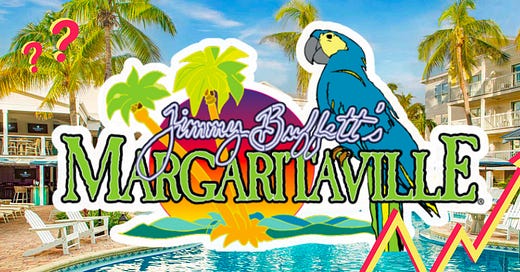Diary of a Brand: Margaritaville
What others can learn from the unexpected fastest growing brand in hospitality
Today’s post covers one of my favorite hotel brands. One of the reasons I love it is because it’s so unexpected. But maybe it shouldn’t be. The brand is Margaritaville - the line of hotels, resorts, and restaurants co-founded by Jimmy Buffett. It’s one of the fastest growing, most profitable, and most beloved brands in the category - so much so that the brand has expanded into casinos, retirement homes, and CPG products. I’m excited to share their story (and a new framework on how to expand a brand to new categories).
Imagine you come into a piece of land that will be developed into a hotel. Which brand would you want to partner with to get the best financial return on your development? Marriott? Hilton? Aman?
If you answered Margaritaville, you’d have to get in line. The brand of hotels and resorts has been on a tear, expanding across the US and Caribbean while delivering some of the strongest operating metrics in the industry.
And it’s not just hotels.
Since the first Margaritaville store opened in 1985, Jimmy Buffett and business partner John Cohlan have done what many lifestyle brands dream of: successfully expand their brand into new categories. Buffett and Cohlan have extended Margaritaville into airport restaurants, pickleball courts, casinos, a Sirius XM station, lines of daiquiri makers, hammocks, beer, clothing, tequila, plus RV parks, cruises and retirement communities.
The brand then cross-sells products to its customer base. Take restaurants, for example. A typical hotel earns 25–30% of its revenue from food and beverage. At Margaritaville’s Hollywood resort, it’s 50%. It makes sense. At a hotel chain like Marriott, there is no distinctive ‘brand idea’ that ties together the experience, so there is no reason to eat at the hotel restaurant (outside of convenience). But for Margaritaville, the restaurant is part of the overall brand experience. You’d be remiss not to grab a Margaritaville margarita.
“People are always shocked when they find out how big we’ve gotten…We just kept quietly doing our thing. Not saying much. And now — bam! — here we are.”
—Jimmy Buffett, NYTimes, 2016
Margaritaville’s estimated $2.2 billion in annual revenue places it around ~10% of the size of Marriott. But while Marriott boasts a portfolio of 30+ brands, Margaritaville has built its company largely off the strength of a single brand.
More impressive are Margaritaville’s operating metrics
Margaritaville enjoyed a direct booking rate of 67% in 2021 (compared to the industry average of 48%), meaning that Margaritaville gets to largely bypass the 20%+ fees charged by OTAs (online travel agencies) like Expedia and Booking.com. Not only is Margaritaville keeping a majority of their booking revenue, they are charging more (average daily rate index vs competitive hotels was 122% in 2021) and selling out their inventory of rooms better than competition (RevPAR index stood at 145.8% in 2021).
How Margaritaville built one of the top performing brands in hospitality
It started with a song. And a licensing dispute. In 1977, Jimmy Buffett released his hit ‘Margaritaville,’ a song about spending a season in a beach resort community, with nothing to show for it but a tattoo that he cannot remember receiving.
I don’t know the reason
Stayed up all season
With nothing to show but a brand-new tattoo
But it’s a real beauty. A Mexican cutie
How it got here, I haven’t a clue, I really don’t knowWasting away again in Margaritaville
Searching for my lost shaker of salt- Margaritaville
The song made Buffett a star, and became an iconic ode to vacation days and an “It’s 5 o’clock somewhere” attitude. In 1983, Buffett decided to turn his fandom into merchandise, only to discover that someone else was already using the Margaritaville name:
“I discovered the Chi Chi’s Restaurant chain had copyrighted the word Margaritaville…I had to reach a settlement with Chi Chi’s to use the name of a song I’d written! Then I found a woman in Hawaii had copyrighted ‘Cheeseburger in Paradise’!… There was a demand there, and everyone was exploiting it but me!” — Library of Congress
While frustrating at the time, these legal disputes may have taught Buffett to make the most of the Margaritaville brand name. He opened the first Margaritaville retail store in Key West in 1985, selling t-shirts and other gear to “Parrotheads,” the name for Margaritaville fans. He followed it up with restaurants in Key West and New Orleans in 1987 and 1993. However, the real growth came when Buffett partnered with financier John Cohlan.
At the time, Mr. Cohlan was SVP of Corporate Finance at Triarc, the investment firm co-founded by Nelson Peltz that counted Snapple, Arby’s and RC Cola as investments. According to Hotel Management Magazine, Cohlan’s time at Triarc gave him “a real understanding of what brands are about.” Peltz relocated the firm to Palm Beach in 1996, and Cohlan developed a rapport with Jimmy and his wife Jane. In 1998, Cohlan went to see Buffett play at the New Orleans Jazz festival, and the opportunity to turn Margaritaville into a brand dawned:
“I was standing there as his guest, watching this off from the side of the stage and looking out at maybe 100,000 deliriously happy fans,” Cohlan said. “I said to myself, “Wow, you know, this could really be a brand.” — The Skift
Jimmy Buffett had a deal on the table to license his name to Universal Studios. He brought the idea to Cohlan, and in 1998, the two decided to establish Margaritaville Holdings as its own business with Cohlan as CEO. Cohlan not only brokered the launch of Margaritaville at Universal Studios in 1999, he also negotiated Margaritaville’s expansion into spirits:
[Universal] had introduced Parrot Bay rum, which Mr. Buffett felt co-opted his band’s Parrot Head imagery. Mr. Cohlan — quite seriously, this time — told Seagram that Margaritaville would boycott its alcohol. In a matter of weeks, Margaritaville had its own tequila and beer brand. — NYTimes
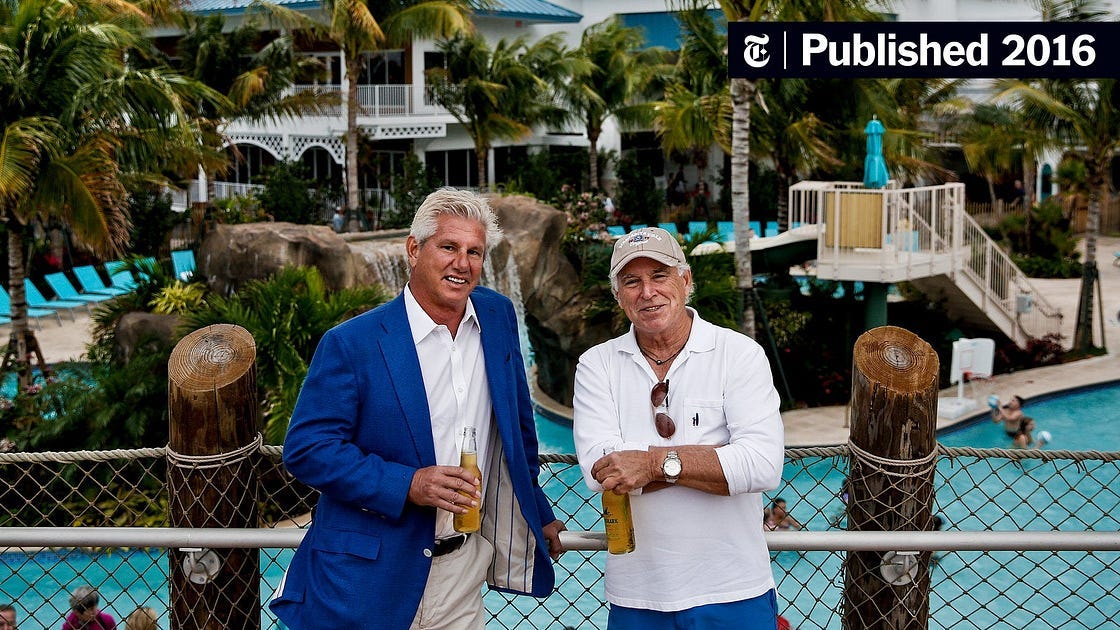
The Universal Studios restaurant was a smash success. The pair began to expand, beginning with a series of retail and dining outlets across the country, as well as licenses for consumer goods and partnerships with retailers HSN and Frontgate to sell them. Media came next, centered on an Sirius XM radio station which now averages 9 million unique weekly listeners. Cohlan and Buffett opened the first Margaritaville-branded hotel in 2010, with the Margaritaville Beach Resort in Pensacola Beach, Florida, with a series of follow on resorts across the US and Mexico.
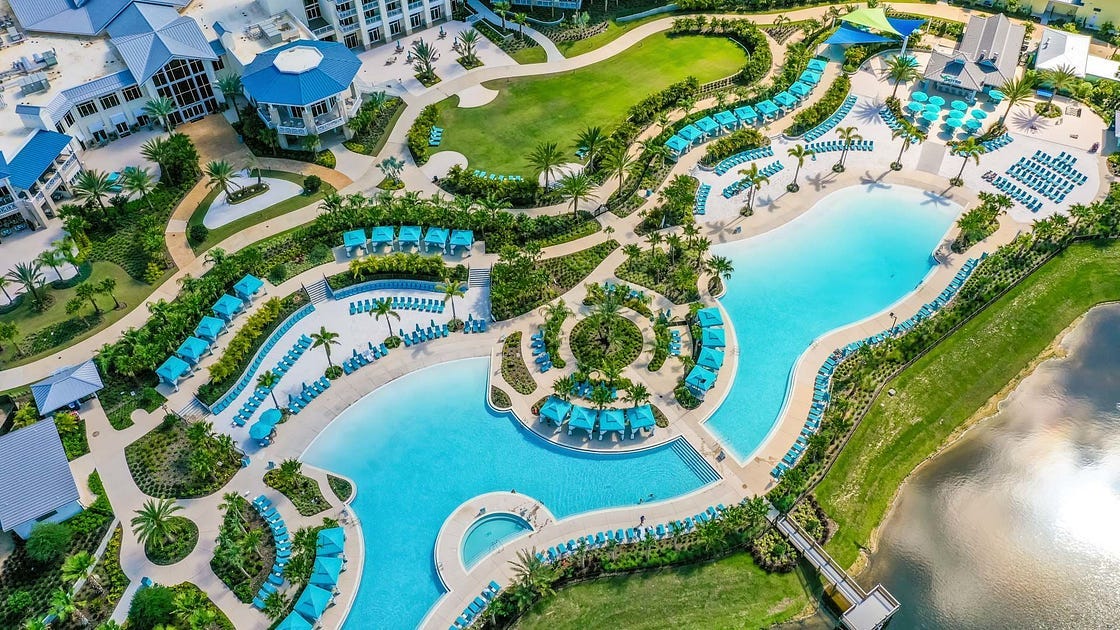
The team has since expanded into casinos and timeshares, with more recent expansion into three fast growing developments:
Latitude retirement communities (for those aged “55 and better”),
Compass select service hotels (a cheaper option under the Margaritaville name),
Camp Margaritaville RV camps (currently 5 locations with bold ambitions to address the $64 Billion RV industry with better amenities, leisure activities, and cross marketing across Margaritaville touchpoints).
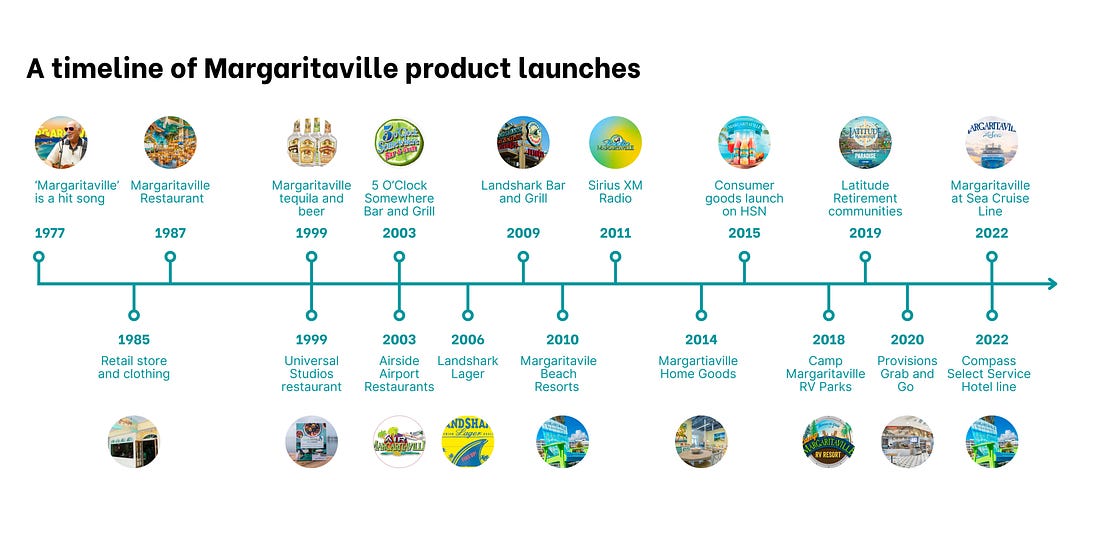
Scaling Margaritaville: the power of Idea-led expansion
Expanding a brand from restaurants into hotels and consumer packaged goods and media and retirement communities sounds like a smart (if not obvious) business strategy, but it is actually quite difficult to pull off. Would you stay in an Olive Garden resort? Or (non-ironically) consider buying a retirement home from the Cheesecake Factory?
In this Diary of a Brand, I am introducing a new framework: Idea-led expansion vs. Product-led expansion, to explain how the Margaritaville team has been able to successfully expand into new categories by leading with their brand idea.
How do you successfully expand a brand to new product categories? Introducing the Idea-led vs. Product Expansion Brand Model
Product-led brands are, unsurprisingly, rooted in product. For example, executives at Hyatt might conclude that the market for lifestyle hotels is significant, and decide to launch their own lifestyle hotel product. They’ll conduct research on trends, uncover customer needs, and design features like locally inspired lobbies to launch their new lifestyle concept, e.g., Andaz (as they did in 2007). As a result, they develop a product aligned to what is currently best in class in the category.

Idea-led expansion is different. It starts with your brand idea as a lens for the category — How would Margaritaville envision this category? Products are designed with the brand idea in mind, resulting in a fresh take that stands out in the category, as well as strong brand consistency across your expanding universe of new products.
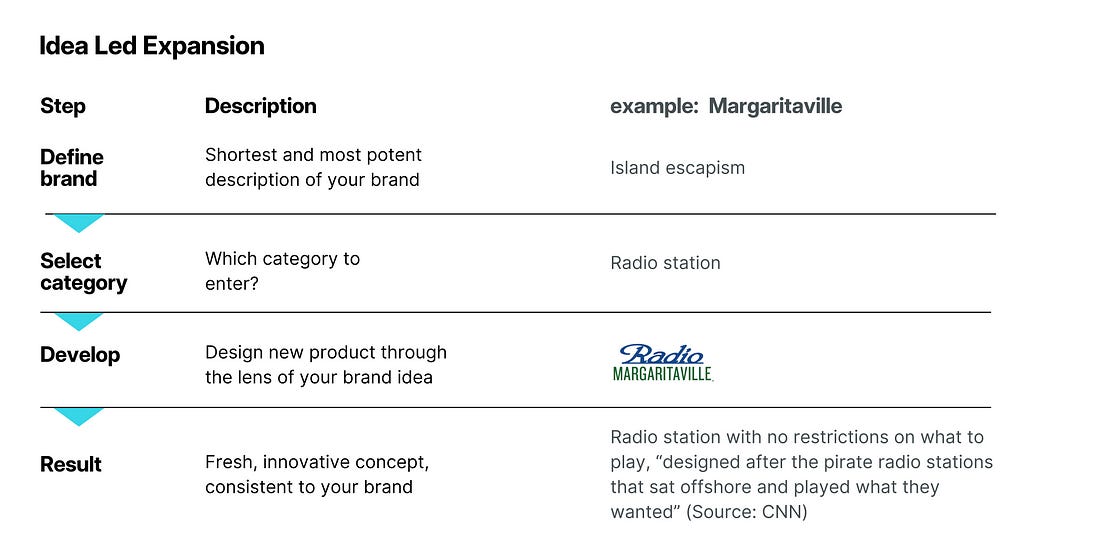
Now, there is a prerequisite: Your brand idea needs to be strong for this to work. If your brand does not provide a unique lens on potential new categories (e.g. is it obvious what a Marriott mini golf course would look like?), go back and define your brand more sharply before attempting to expand into other categories.
For example, Margaritaville used idea-led expansion to launch their rewards program.
Most rewards programs are similar — you rack up points by spending with a brand, which you can then spend on more things.
In a product-led expansion strategy, Margaritaville might have asked people what they want from a rewards program (rewards) and designed a program following existing industry playbooks (rewards, tiers, digital app). Instead, they looked to their brand as a lens for expansion. The core idea of Margaritaville is vacation, or Island Escapism. How would that apply to a loyalty scheme? Well they got rid of points. And tiers. They just offer benefits, in the form of free amenities, discounts, food, and other perks.
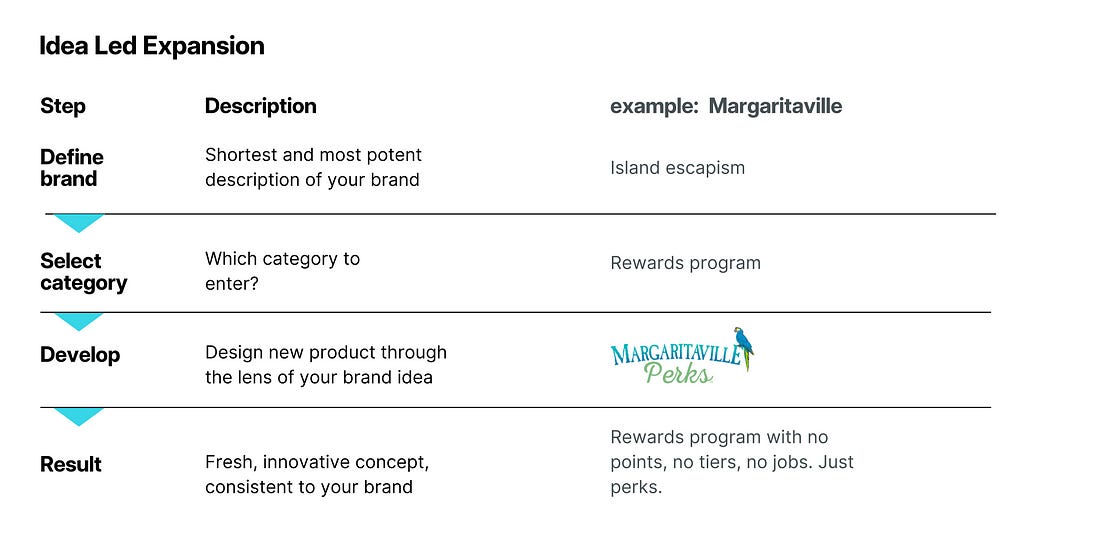
“Margaritaville, the global lifestyle brand synonymous with fun and escapism, announces Margaritaville Perks, a complete departure from the traditional, everyday loyalty program. With no points, levels to reach, or waiting for qualification, Margaritaville Perks offers guests simple and immediate perks, value-adds, and benefits.”
It makes perfect sense — if your brand is about vacationing, why are you giving your customers a low paying part time job?
If your brand is about vacationing, why are you giving your customers a low paying part time job?
Margaritaville learned the importance idea-led expansion the hard way.
When Margaritaville expanded to beer, sales were lackluster. The reason? They failed to think brand idea first, and the product did not connect to the budding Margaritaville universe:
“For starters, that early beer, Lone Palm Lager, named after one of Mr. Buffett’s songs, did not sell as they had hoped. “We only found out later, after we did consumer research to figure out what was going on, that the name bummed people out because it made them think about drinking alone,” Mr. Cohlan said. They renamed it LandShark Lager, a nod to Mr. Buffett’s song “Fins.” Ta-da: Sales started to take off.
— NYTimes
Now, every Margaritaville expansion is idea-led.
Margaritaville operates an asset light model (similar to Marriott and Hilton). This means investors and operators build the products (e.g. hotels, cruises) and operate them. Nevertheless, team Margaritaville is involved in the delivery of every brand experience — even if it means funding the experience themselves:
Pat McBride’s design firm…helped come up with the idea of having a statue of an 11-foot-high pair of flip-flops as one of the hotel’s visual elements. The developer cut the flip-flops from the plan for budget reasons, saying it wasn’t functionally needed. “No, we have to have it,” [Cohlan] told him. “We will own it ourselves — which we still do.”
Investments like these are hard to track (what’s the ROI on a giant flip flop?) but they build the overall idea of the brand — which is a capital asset that gets cemented in customers minds’. Once an idea is clear to audiences (i.e. customers are aware of it) the brand can leverage that awareness to sell new products to the same customers.
Our brand reputation and perception are extremely important to us. When we open a new property, launch a new product or expand upon the brand in any way, it’s crucial for us to ensure all aspects of the project align with our core values of fun and escapism.
Idea-led expansion isn’t just for hospitality
Makeup and skincare brand Glossier is another example of an idea-led brand. Cosmetics brands often gain initial success with a hero product, but struggle to sell additional categories across the brand except to a minority of customers. For example, makeup brand Anastasia is best known for its eyebrow products. Kylie Cosmetics is synonymous with lip glosses and kits.
On the other hand, Glossier has multiple ‘hero’ products across eyebrows (Boy Brow), lips (Balm Dotcom), cleaners (Milky Jelly), blush (Cloud Paint), even sweatshirts that customers are proud to don. Last year, Glossier expanded to perfume with Glossier You, which became Sephora’s top selling perfume of 2023.
How has Glossier managed to successfully launch so many products?
Glossier knows who they are, and uses that knowledge to inform the development of products that align to their overall brand first, rather than simply release what’s trending and best-in-class in the category. The result? Glossier has created a category of its own, with a clear thread across products that are also each individually innovative enough to garner sales.
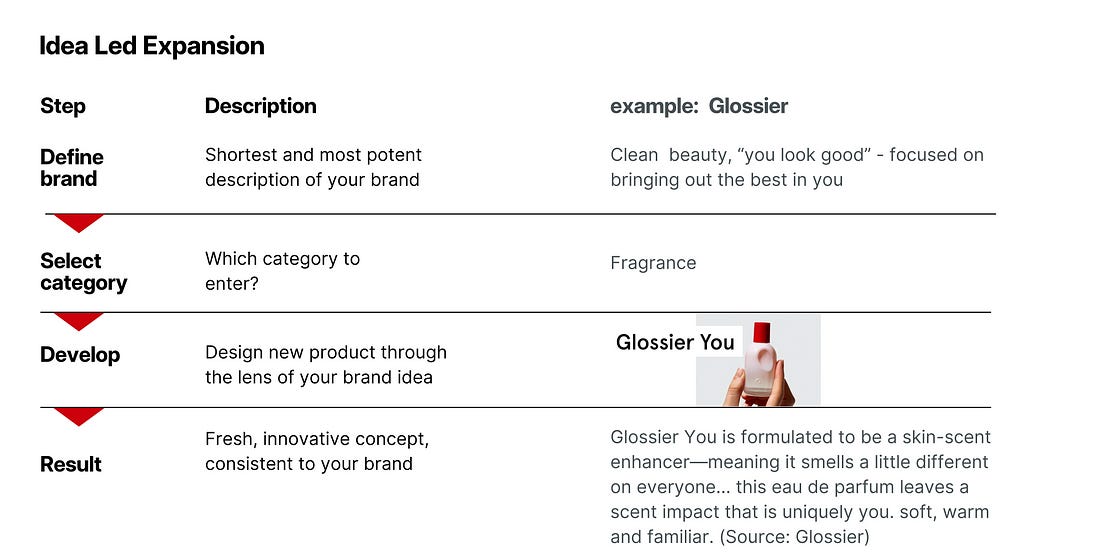
Other ‘idea’ brands with successful category expansion include Apple (computers to phones, headphones and streaming services), Harley Davidson (motorcycles to clothes and experiences), and Yeti (coolers to bags and bottles and apparel). I
Executing idea-led expansion
It’s easy to immediately jump to brainstorming potential categories for expansion. But the strongest brands start by looking inwards: who are we, really? Why did we start this company? Who is our customer, and why do they choose us? What’s the emotional core of our brand? Answers here provide the lens to define a brand and design new-to-market products.
Marketing is more efficient as a result: budget can be split at the brand and product level, allowing for economies of scale with the parent brand selling multiple products, while existing customers serve as audiences (and if you do it right, fans) who sign up to try new products first.
Idea-led expansion requires a shift in thinking — particularly around marketing. Instead of seeing marketing as a way to support new products, idea-led marketers view the products themselves as marketing for the larger brand idea, which takes precedence over everything else.
Margaritaville and the brand flywheel model
In all of the Diary of a Brand pieces, I evaluate how the brand connects marketing, price, and product to underlying operations. For example, IKEA’s flat pack furniture, out of city locations, and reliance on customers to assemble goods allow IKEA to save costs and invest in a killer offering of good design at low prices.
How do Margaritaville’s elements link together? Margaritaville’s model is self-reinforcing — a good sign — and no surprise given their ability to expand their brand DNA to multiple concepts.
Brand and Product link: Margaritaville’s brand of Island Escapism comes to life across all of its products, from amenities to location choices (often chosen based on ability to drive to them as a way to offer an easy escape to a Margaritaville mindset) to training of employees:
I often say that at our core we’re a training company; we’re about training the people who interface with our guests….If the people working at the property are having fun, the people staying there will also have fun. — John Cohlan (Youtube)
Product and Price link: Margaritaville’s unique, comfortable and highly-rated experience link well to premium pricing. Luxury would feel out of place with the brand, and discount pricing would not offer room to deliver the Margaritaville experience.
Brand, Product, Price and Operations link: Most importantly, Margaritaville supports their brand idea with an aligned operating model. Cohlan and Buffett’s strategy of licensing the brand allow for fast expansion to new categories, while their insistence on strong brand guidelines (even if they have to enforce and/or invest in amenities and training themselves) maintains consistency across category expansions, paying dividends in the form of strong customer reviews, cross selling, and direct bookings (avoiding margin-reducing OTAs like Expedia).
A final point: Emotions scale more easily than features
The phrase ‘product design’ inspires images of attractive aesthetics and innovative features. But Cohlan and Buffett recognized that the ultimate product attribute is the ability to generate emotion. A feature can differentiate a product, but an emotion inspires differentiation across categories:
“Emotions can travel much further than a traditional product in terms of brand extensions because emotion can apply to many things… Brands like Kleenex or Marriott are defined by products that don’t have many logical extensions, while an emotion like Margaritaville is relevant in various ways.” — John Cohlan, The Skift
If you’re looking to map a route to brand growth, the starting point may not be in innovative product features or updated technology, but in understanding people — which opens the door to a rich brand idea that will inspire many products.
“The stroke of genius was making Margaritaville a feeling, not a place…If you don’t take the name so literally, growth could be endless.” — Mindy Grossman, CEO, HSN and Frontgate, NYTimes

